Visual Simulation Research on Growth Polymorphism of Chinese Fir Stand Based on Different Comprehensive Grade Models of Spatial Structure Parameters
Abstract
:1. Introduction
2. Materials and Methods
2.1. Study Area and Data Collection
2.2. Construction of Comprehensive Grade Model of Spatial Structure (CGMSS)
2.3. Fitting of Growth Model of Chinese Fir’s Morphological Structure
2.3.1. DBH Growth Model
2.3.2. H, CW and UBH Growth Model
2.4. Evaluation of Model Accuracy
2.5. Dynamic Visual Simulation of Chinese Fir Morphological Structure
3. Results
3.1. Comprehensive Grade Model of Spatial Structure (CGMSS)
3.2. Morphological–Structural Growth Model of CHINESE Fir
3.3. Dynamic Visual Simulation of the Morphological Structure of Chinese Fir Stand
4. Discussion
5. Conclusions
Author Contributions
Funding
Data Availability Statement
Conflicts of Interest
References
- Meyer, P.; Ammer, C. Forest Management. In Disturbance Ecology; Landscape Series; Springer: Berlin, Germany, 2022; pp. 315–347. [Google Scholar] [CrossRef]
- Li, Y.; Zhang, H.; Ju, H.; Jiang, X. Visual Simulation Technique of Decision Making of Interactive Stand Management Methods. In Proceedings of the 2014 International Conference on Virtual Reality and Visualization, Shenyang, China, 30–31 August 2014; pp. 459–466. [Google Scholar] [CrossRef]
- Yu, H.; Wu, M.M.; He, H.S. Developing platform of 3-d visualization of forest landscape. Environ. Modell. Softw. 2022, 157, 105524. [Google Scholar] [CrossRef]
- Bowman, D.M.; Brienen, R.J.; Gloor, E.; Phillips, O.L.; Prior, L.D. Detecting trends in tree growth: Not so simple. Trends Plant Sci 2013, 18, 11–17. [Google Scholar] [CrossRef]
- Jin, S.; Zhang, W.; Shao, J.; Wan, P.; Cheng, S.; Cai, S.; Yan, G.; Li, A. Estimation of Larch Growth at the Stem, Crown, and Branch Levels Using Ground-Based LiDAR Point Cloud. J. Remote Sens. 2022, 2022, 12. [Google Scholar] [CrossRef]
- Han, Y.; Wu, B.; Wang, K.; Guo, E.; Dong, C.; Wang, Z. Individual-tree form growth models of visualization simulation for managed larix principis-rupprechtii plantation. Comput. Electron. Agric. 2016, 123, 341–350. [Google Scholar] [CrossRef]
- de Reffye, P.; Hu, B.; Kang, M.; Letort, V.; Jaeger, M. Two decades of research with the GreenLab model in agronomy. Ann Bot 2021, 127, 281–295. [Google Scholar] [CrossRef] [PubMed]
- Griffon, S.; De Coligny, F. AMAPstudio: A software suite for plants architecture modelling. In Proceedings of the IEEE 4th International Symposium on Plant Growth Modeling, Simulation, Visualization and Applications (PMA12), Shanghai, China, 31 October–3 November 2012; pp. 141–147. [Google Scholar]
- Kang, M.; Wang, X.; Hua, J.; Hu, B.; Wang, F.; De Reffye, P. Over two decades of research with Greenlab model. J. Agric. Big Data 2021, 3, 3–12. [Google Scholar] [CrossRef]
- Peng, F.; Zheng, H.; Lu, S.; Shi, Z.; Liu, X.; Li, L. Growth model and visualization of a virtual jujube tree. Comput. Electron. Agric. 2019, 157, 146–153. [Google Scholar] [CrossRef]
- Söderbergh, I.; Ledermann, T. Algorithms for simulating thinning and harvesting in five european individual-tree growth simulators: A review. Comput. Electron. Agric. 2003, 39, 115–140. [Google Scholar] [CrossRef]
- Chen, K.; Zhang, H.-Q.; Liu, M.; Lu, K.-N. Cunninghamia Lanceolata Three-Dimensional Modeling Technology Based on IFS Fractal Algorithms. In Proceedings of the 2010 International Conference on Computational Intelligence and Software Engineering, Wuhan, China, 10–12 December 2010; pp. 1–4. [Google Scholar] [CrossRef]
- Lei, X.; Chang, M.; Lu, Y.; Zhao, T. A review on growth modelling and visualization for virtual trees. Sci. Silvae Sin. 2006, 42, 123. [Google Scholar]
- Looney, C.E.; Zhang, J. Site quality and intensive early stand management practices affect growth dominance, structural complexity, and tree growth in ponderosa pine plantations. For. Ecol. Manag. 2022, 519, 120318. [Google Scholar] [CrossRef]
- Hui, G.; Hu, Y.; Zhao, Z. Research progress of structure-based forest management. For. Res. 2018, 31, 85–93. [Google Scholar] [CrossRef]
- Ma, Z.; Zhang, H.; Li, Y.; Yang, T.; Huang, R.; Li, S. 3D visual simulation of Chinese fir based on the influence of different stand spatial structures. In Proceedings of the 2017 2nd International Conference on Image, Vision and Computing (ICIVC), Chengdu, China, 2–4 June 2017; pp. 559–565. [Google Scholar] [CrossRef]
- Kang-ning, L.; Huai-qing, Z.; Min, L.; Kang, C. Research on Tree Growth Models and Visual Simulation Technology. In Proceedings of the 2010 International Conference on Computational Intelligence and Software Engineering, Wuhan, China, 10–12 December 2010. [Google Scholar] [CrossRef]
- Falcão, A.O.; Santos, M.P.D.; Borges, J.G. A real-time visualization tool for forest ecosystem management decision support. Comput. Electron. Agric. 2006, 53, 3–12. [Google Scholar] [CrossRef]
- Kuang, Y.; Zhang, H.; Tan, J.; Jiang, X.; Lu, K.; Zhang, N. The study of the stand simulation based on the spatial structure. In Proceedings of the 2012 IEEE 4th International Symposium on Plant Growth Modeling, Simulation, Visualization and Applications, Shanghai, China, 31 October–3 November 2012; pp. 200–203. [Google Scholar] [CrossRef]
- Dong, L.; Liu, Z. Visual management simulation for Pinus svlvestris var. mongolica plantation based on optimized spatial structure. Sci. Silvae Sin. 2012, 48, 77–85. [Google Scholar]
- Li, S.; Zhang, H.; Li, Y.; Yang, T.; Shen, K. Three-Dimensional Visualization Simulation of Chinese Fir Stand Growth Based on Unity3D. In Proceedings of the 2018 3rd International Conference on Mechanical, Control and Computer Engineering (ICMCCE), Huhhot, China, 14–16 September 2018; pp. 530–534. [Google Scholar] [CrossRef]
- Wang, H. Dynamic Simulating System for Stand Growth of Forests in Northeast China. Ph.D. Thesis, Northeast Forestry University, Harbin, China, 2012. [Google Scholar]
- Gao, G.; Ding, G.; Xiao, M.; Zhang, L.; Lv, R.; Zhang, X.; Li, W.; Liu, Y. A Study on Stand Visualization of Artificial Mixed Forests. Bull. Soil Water Conserv. 2012, 32, 158–162. [Google Scholar] [CrossRef]
- Kershaw, J.A.; Richards, E.W.; Mccarter, J.B.; Oborn, S. Spatially correlated forest stand structures: A simulation approach using copulas. Comput. Electron. Agric. 2010, 74, 120–128. [Google Scholar] [CrossRef]
- Zhu, N.; Zhang, H.; Cui, Z.; Yang, T.; Li, Y.; Liu, H. Visual simulation of Chinese fir under branch height in consideration of spatial structure. J. Nanjing For. Univ. 2022, 46, 51–57. [Google Scholar]
- Li, S.; Zhang, H.; Li, Y.; Yang, T.; He, J.; Ma, Z.; Shen, K. Dynamic Visual Simulation of Chinese Fir Stand Growth Based on Sample Library. For. Res. 2019, 32, 21–30. [Google Scholar] [CrossRef]
- Ma, Z.; Zhang, H.; Li, Y.; Yang, T.; Chen, Z.; Li, S. Visual Simulation of Chinese Fir Crown Growth Based on Spatial Structure. For. Res. 2018, 31, 150–157. [Google Scholar] [CrossRef]
- Haara, A.; Pykäläinen, J.; Tolvanen, A.; Kurttila, M. Use of interactive data visualization in multi-objective forest planning. J. Environ. Manag. 2018, 210, 71–86. [Google Scholar] [CrossRef]
- Hui, G.; Gadow, K.V. Principles on Structure-Based; China Forestry Publishing House: Beijing, China, 2016; p. 360. [Google Scholar]
- Cao, X.; Li, J.; Feng, Y.; Hu, Y.; Zhang, C.; Fang, X.; Deng, C. Analysis and evaluation of the stand spatial structure of Cunninghamia lanceolata ecological Forest. Sci. Silvae Sin. 2015, 51, 37–48. [Google Scholar]
- Põldveer, E.; Korjus, H.; Kiviste, A.; Kangur, A.; Paluots, T.; Laarmann, D. Assessment of spatial stand structure of hemiboreal conifer dominated forests according to different levels of naturalness. Ecol. Indic. 2020, 110, 105944. [Google Scholar] [CrossRef]
- Hui, G.; Gadow, K.V.; Albert, M. A new parameter for stand spatial structure neighborhood comparison. For. Res. 1999, 12, 4–9. [Google Scholar]
- Hu, Y.; Hui, G. How to describe the crowding degree of trees based on the relationship of neighboring trees. J. Beijing For. Univ. 2015, 37, 1–8. [Google Scholar] [CrossRef]
- Hui, G.; Hu, Y.; Zhao, Z.; Yuan, S.; Liu, W. A Forest Competition Index Based on Intersection Angle. Sci. Silvae Sin. 2013, 49, 68–73. [Google Scholar]
- Zhao, Z.; Hui, G.; Hu, Y.; Li, Y.; Wang, H. Method and application of stand spatial advantage degree based on the neighborhood comparison. J. Beijing For. Univ. 2014, 36, 78–82. [Google Scholar] [CrossRef]
- Hui, G.; Zhao, Z.; Zhang, G. Priority of management measures for natural forests based on the stand state. J. Beijing For. Univ. 2016, 38, 1–10. [Google Scholar] [CrossRef]
- Xie, Y.; Yang, H. Relationship between stand spatial structure and DBH increment of principal species in natural spruce-fir mixed forest in Changbai Mountains of northeastern China. J. Beijing For. Univ. 2022, 44, 1–11. [Google Scholar]
- Cortini, F.; Filipescu, C.N.; Groot, A.; Macisaac, D.A.; Nunifu, T. Regional models of diameter as a function of individual tree attributes, climate and site characteristics for six major tree species in Alberta, Canada. Forests 2011, 2, 814–831. [Google Scholar] [CrossRef] [Green Version]
- Zhou, Z.; Fu, L.; Zhou, C.; Sharma, R.P.; Zhang, H. Simultaneous compatible system of models of height, crown length, and height to crown base for natural secondary forests of Northeast China. Forests 2022, 13, 148. [Google Scholar] [CrossRef]
- Wei, X.; Sun, Y.; Ma, W. A height growth model for Cunninghamia lanceolata based on Richards’ equation. J. Zhejiang A&F Univ. 2012, 29, 661–666. [Google Scholar]
- Sánchez-González, M.; Cañellas, I.; Montero, G. Generalized height-diameter and crown diameter prediction models for cork oak forests in Spain. Forest Syst. 2007, 16, 76–88. [Google Scholar] [CrossRef] [Green Version]
- Dong, C.; Wu, B.; Zhang, H. Parametric prediction models of DBH and height for Cunninghamia lanceolata plantation based on crown width. J. Beijing For. Univ. 2016, 38, 55–63. [Google Scholar] [CrossRef]
- Mayerich, D.; Chen, G.; Childs, H. Unreal Chimera: An Unreal Engine Platform for Scientific Visualization of Next-Generation Data. Available online: https://stim.ee.uh.edu/resources/software/unreal-microscopy/ (accessed on 20 February 2022).
- Zhang, H. Researchs on Single Wood Growth Model of Fokienia hodginsii. Cent. South For. Inventory Plan. 2006, 25, 1–4. [Google Scholar]
- Pretzsch, H. Tree growth as affected by stem and crown structure. Trees 2021, 35, 947–960. [Google Scholar] [CrossRef]
- González-Moreno, P.; Quero, J.L.; Poorter, L.; Bonet, F.J.; Zamora, R. Is spatial structure the key to promote plant diversity in mediterranean forest plantations? Basic Appl. Ecol. 2011, 12, 251–259. [Google Scholar] [CrossRef]
- Duchateau, E.; Schneider, R.; Tremblay, S.; Dupont-Leduc, L.; Pretzsch, H. Modelling the spatial structure of white spruce plantations and their changes after various thinning treatments. Forests 2021, 12, 740. [Google Scholar] [CrossRef]
- Robert, A. Simulation of the effect of topography and tree falls on stand dynamics and stand structure of tropical forests. Ecol. Model. 2003, 167, 287–303. [Google Scholar] [CrossRef]
- Gonzalez-Benecke, C.A.; Gezan, S.A.; Leduc, D.J.; Martin, T.A.; Cropper, W.P., Jr.; Samuelson, L.J. Modeling survival, yield, volume partitioning and their response to thinning for longleaf pine plantations. Forests 2012, 3, 1104–1132. [Google Scholar] [CrossRef]
- Qiu, H.; Liu, S.; Zhang, Y.; Li, J. Variation in height-diameter allometry of ponderosa pine along competition, climate, and species diversity gradients in the western united states. For. Ecol. Manag. 2021, 497, 119477. [Google Scholar] [CrossRef]
- Zhang, M.; Liu, N.; Harper, R.; Li, Q.; Liu, K.; Wei, X.; Ning, D.; Hou, Y.; Liu, S. A global review on hydrological responses to forest change across multiple spatial scales: Importance of scale, climate, forest type and hydrological regime. J. Hydrol. 2017, 546, 44–59. [Google Scholar] [CrossRef] [Green Version]
- Lu, K.; Zhang, H. A Review of Plant Architecture. World For. Res. 2010, 23, 17–20. [Google Scholar] [CrossRef]

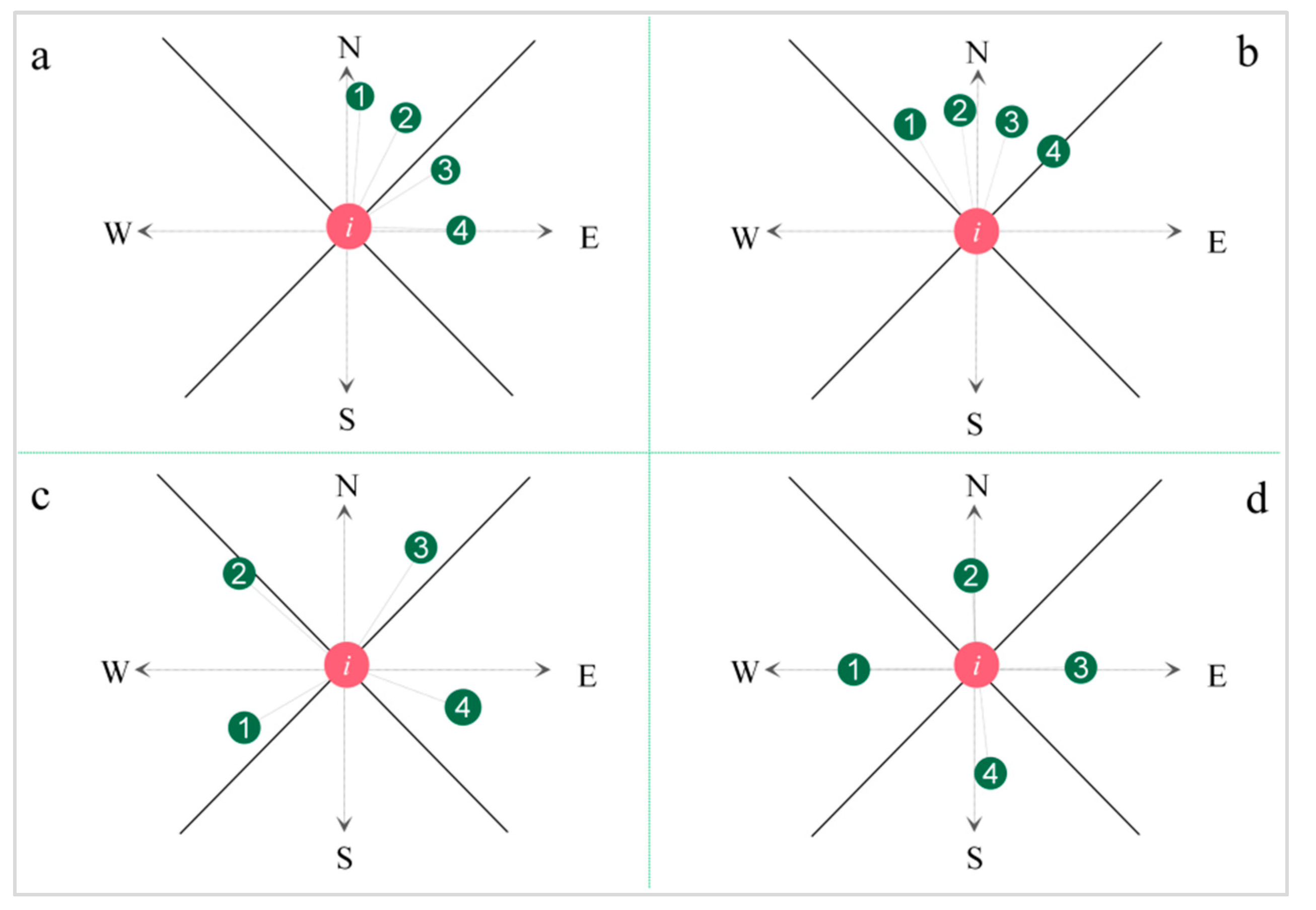


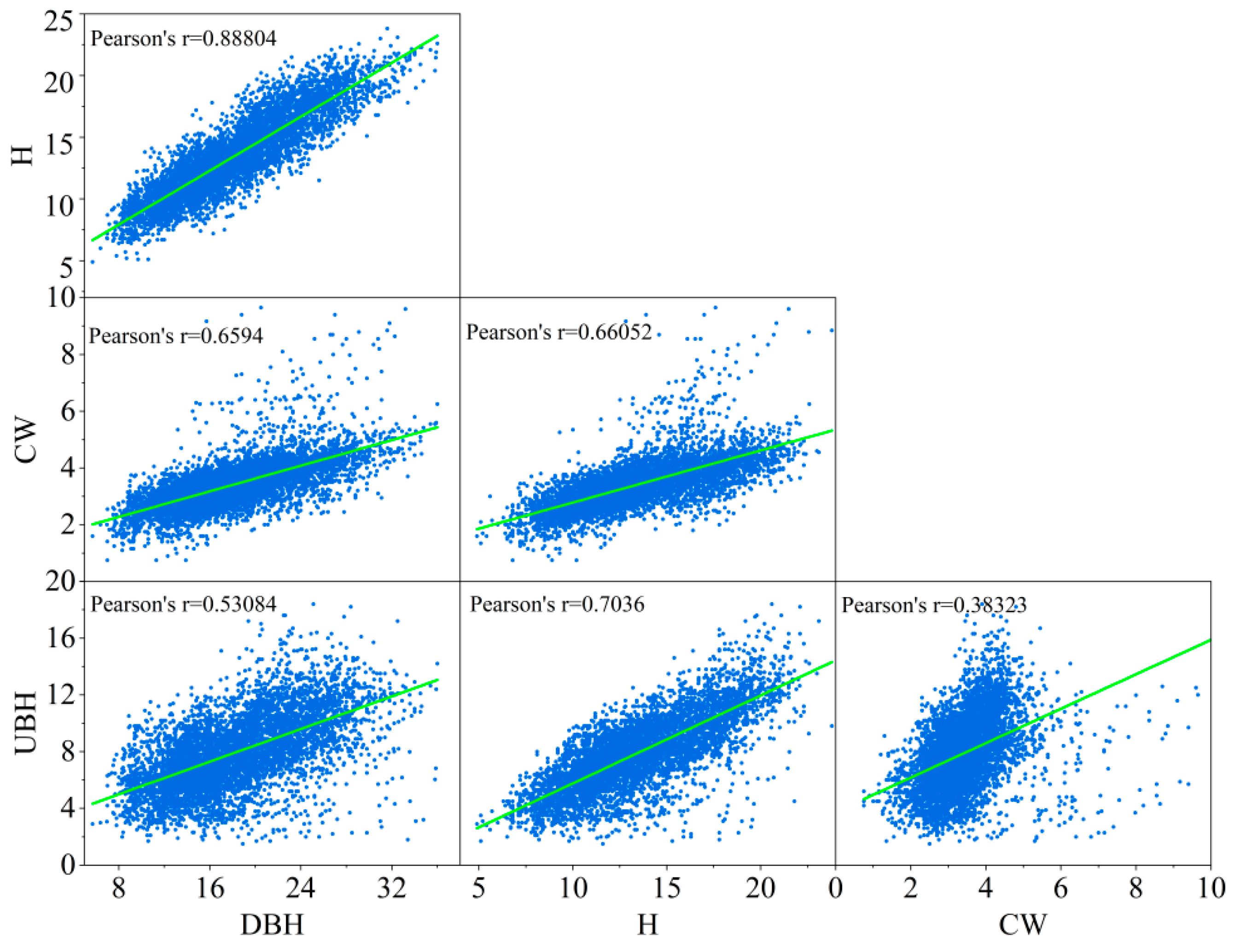
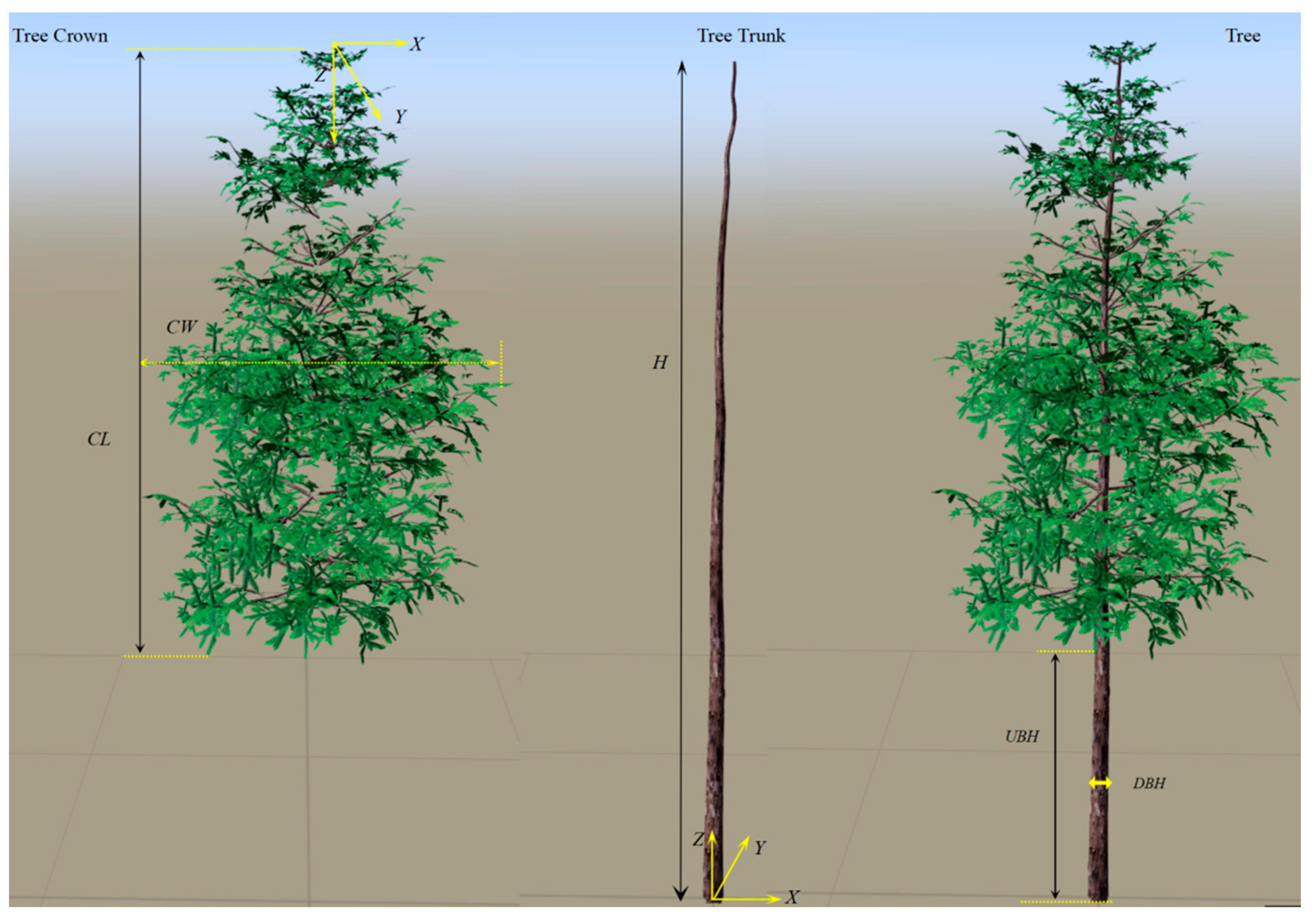

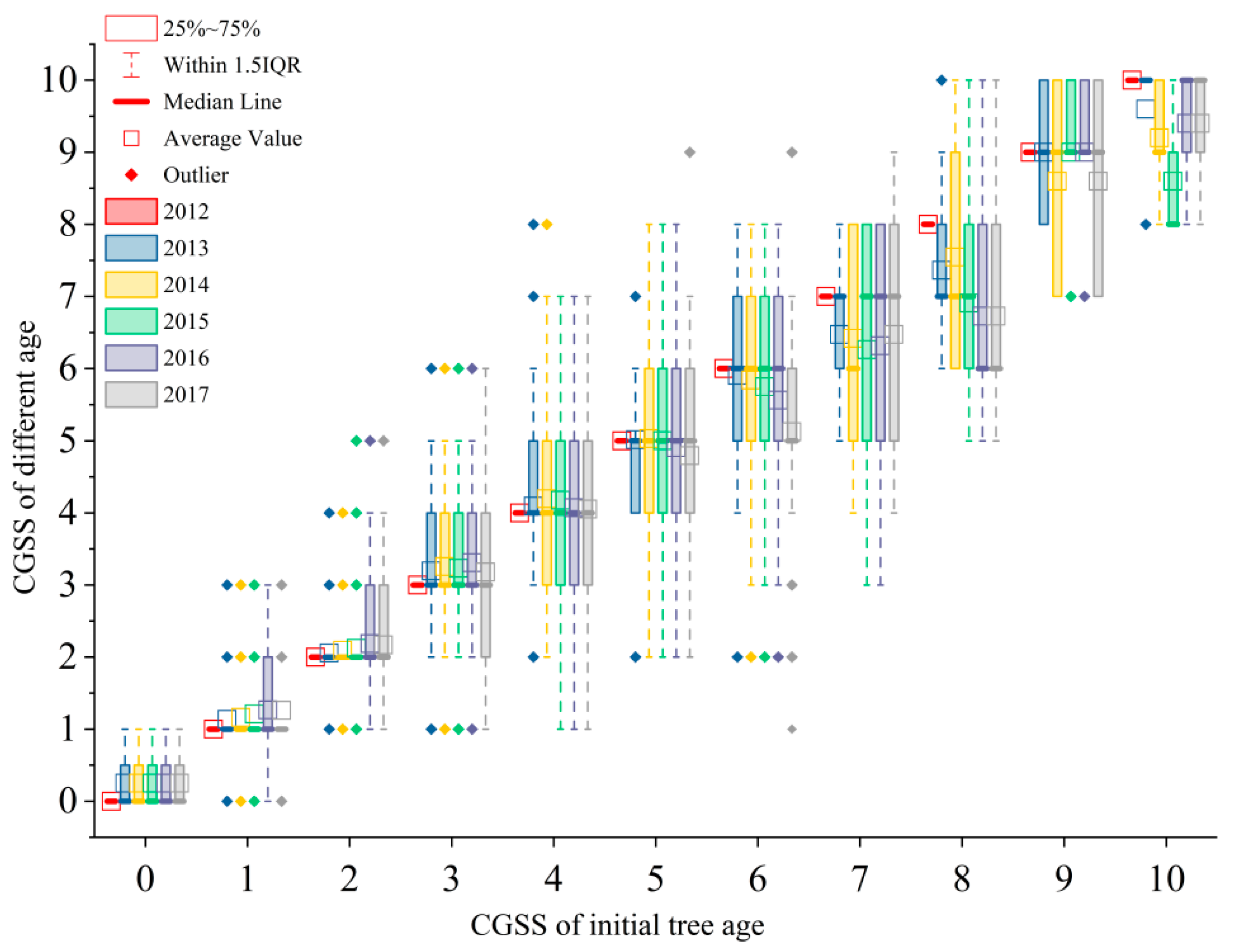

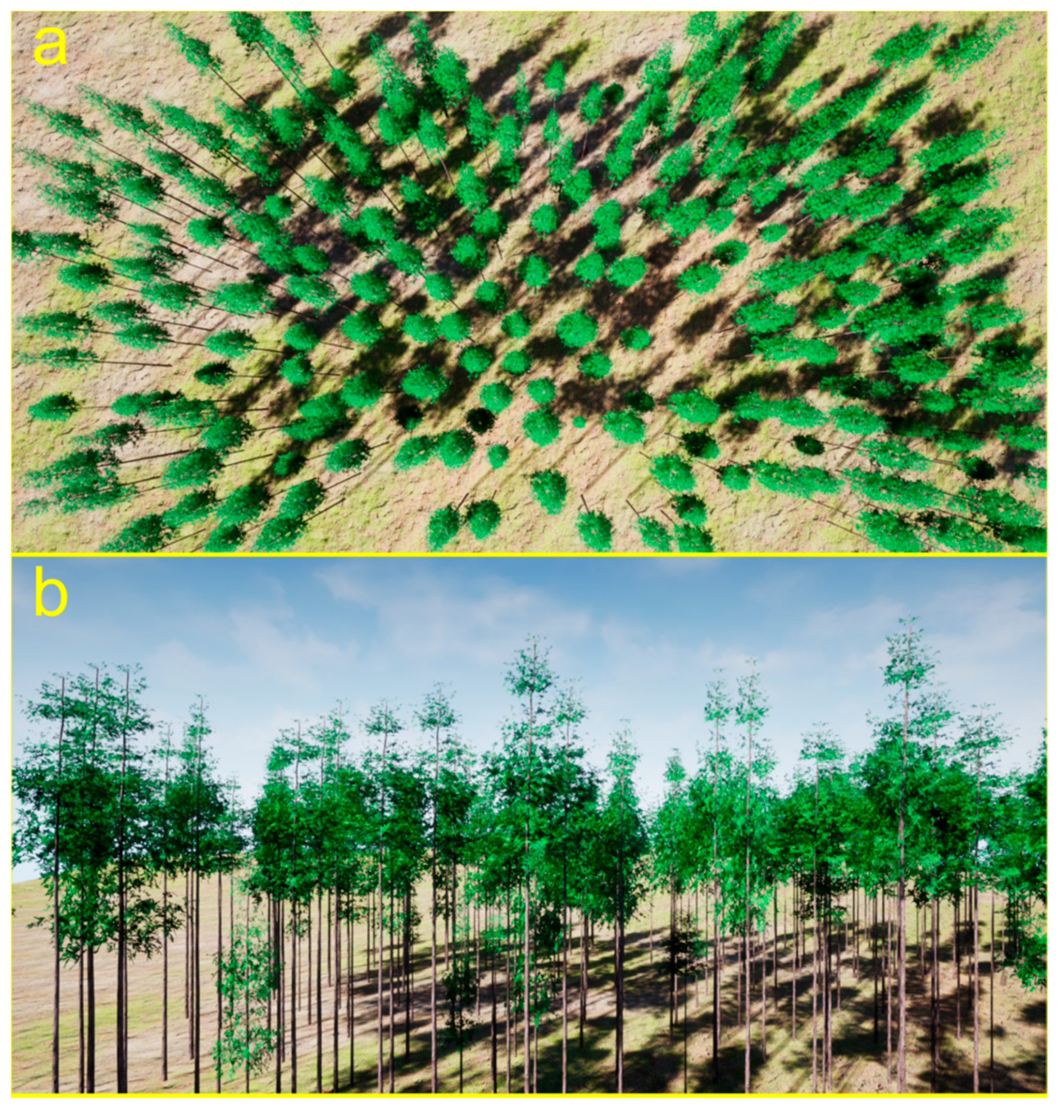
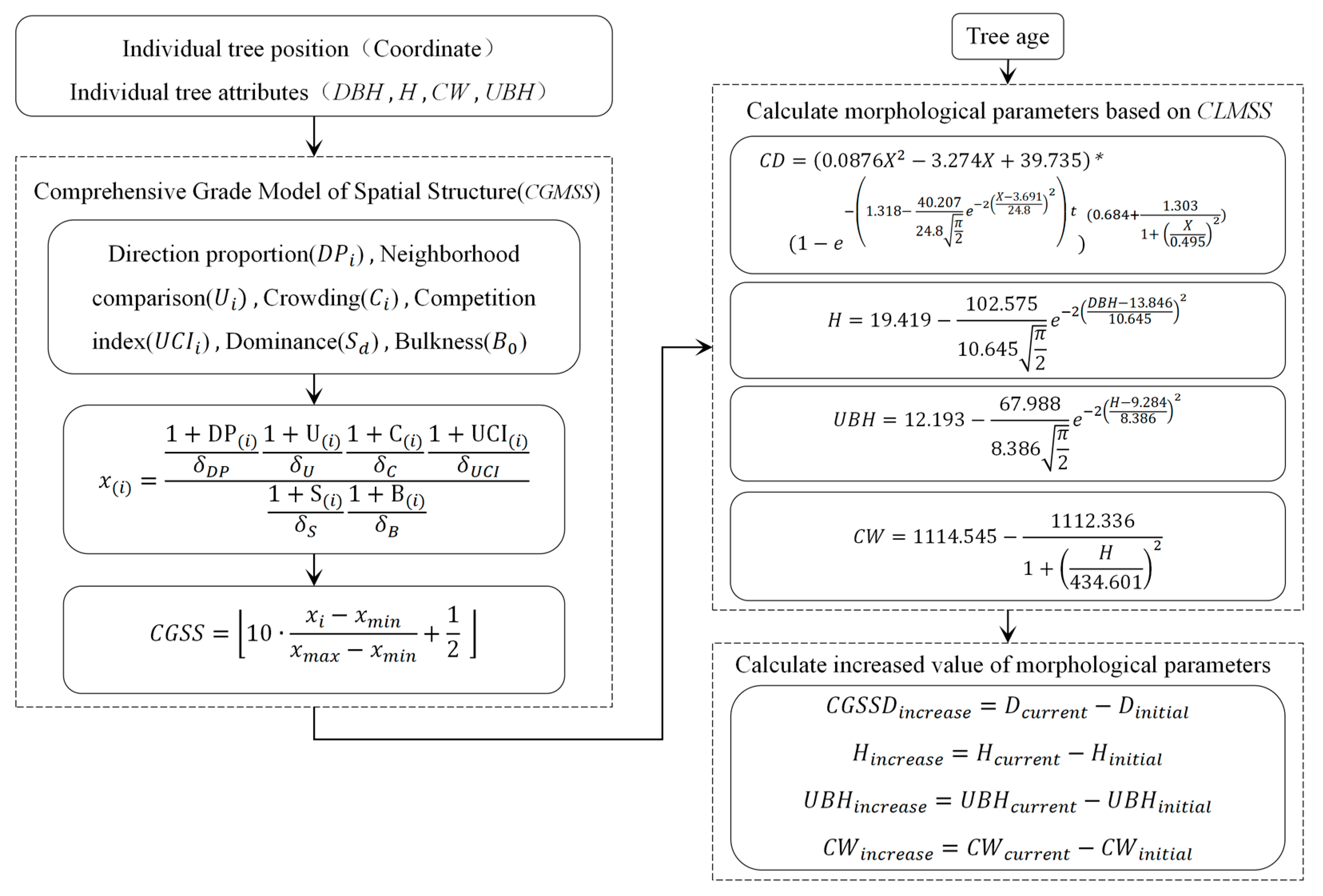

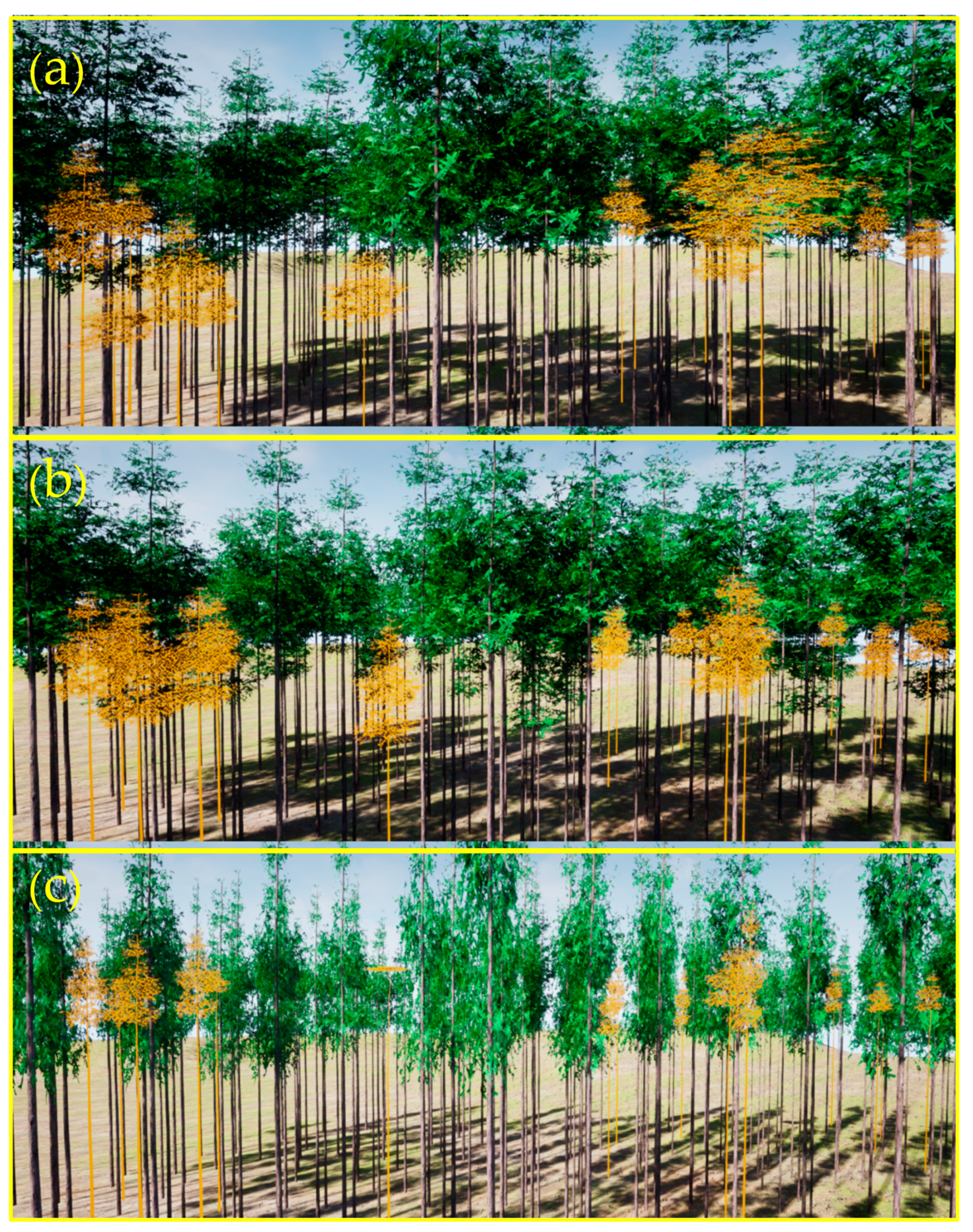
| Plot Number | Age Span | Quantity/Plant | Area/hm2 | DBH Range/cm | H Range/m | UBH Range/m | CW Range/m |
|---|---|---|---|---|---|---|---|
| A | 17~22 | 533 | 0.36 | 7.1~16.2~28.6 | 4.3~10.6~18.0 | 1.7~5.0~9.3 | 0.6~2.7~3.8 |
| B | 23–28 | 362 | 0.4 | 13.3~22.6~33.4 | 8.4~15.4~20.2 | 1.8~8.2~12.2 | 1.3~2.9~4.2 |
| C | 11–16 | 309 | 0.25 | 5.9~14.2~21.2 | 5.3~9.5~13.5 | 1.9~4.3~7.5 | 0.8~2.7~4.0 |
| D | 10–15 | 955 | 0.48 | 3.2~11.6~22.4 | 3.2~8.4~13.7 | 1.3~4.4~8.0 | 0.3~2.2~3.8 |
| E | 16–21 | 230 | 0.36 | 10.5~20.0~29.8 | 6.7~12.8~16.8 | 2.6~6.6~9.2 | 1.6~3.0~4.5 |
| F | 13–18 | 120 | 0.16 | 6.2~16.5~23.2 | 5.6~11.0~13.8 | 1.8~6.3~9.5 | 1.8~3.4~5.6 |
| Model Name | Model Expression | Explanation |
|---|---|---|
| Neighborhood comparison [32] | represents the number of adjacent trees (the same as below), and is a discrete variable, which means that when the diameter of the center tree is smaller than that of the adjacent tree ,, otherwise . | |
| Crowding [33] | represents the density of the center tree ; is a discrete variable, which takes a value of 1 when the crown of adjacent tree overlaps with center tree , otherwise, it is 0. | |
| a forest competition index based on intersection angle [34] | When the adjacent tree is larger than the center tree ,, otherwise When the adjacent tree is larger than the center tree ,. means the intersection angle competition index;, means the included angle; means the neighborhood comparison, which means the weight;, means the height of the center tree and adjacent trees; means the parameter, value is 0 or 1. | |
| tree spatial advantage degree [35] | is the probability that the DBH of other trees in the stand is smaller than the center tree; is the potential maximum cross-sectional area of the tree, and the value of the largest cross-sectional area of the tree in the stand is used as the potential size of the tree growth; is the cross-sectional area of the center tree(the same as below). | |
| forest density of stocking [36] |
| Equation | Parameters | Model Name | Model Expression |
|---|---|---|---|
| (6) | a | Quadratic polynomial | |
| (7) | k | Gauss | |
| (8) | c | Logistic |
| Equation | Parameters | Model Expression |
|---|---|---|
| (9) | H | |
| (10) | UBH | |
| (11) | CW |
| Pearson’s Correlation | No | CGSS | ||||||||||
|---|---|---|---|---|---|---|---|---|---|---|---|---|
| 0 | 1 | 2 | 3 | 4 | 5 | 6 | 7 | 8 | 9 | 10 | ||
| H:DBH | 0.90 | 0.94 | 0.91 | 0.94 | 0.94 | 0.95 | 0.96 | 0.95 | 0.95 | 0.97 | 0.97 | 0.98 |
| H:CW | 0.84 | 0.71 | 0.65 | 0.78 | 0.87 | 0.87 | 0.86 | 0.91 | 0.91 | 0.94 | 0.98 | 0.96 |
| H:UBH | 0.84 | 0.94 | 0.74 | 0.85 | 0.87 | 0.74 | 0.91 | 0.91 | 0.91 | 0.95 | 0.98 | 0.94 |
| DBH:UBH | 0.61 | 0.89 | 0.6 | 0.77 | 0.76 | 0.69 | 0.84 | 0.86 | 0.86 | 0.93 | 0.96 | 0.91 |
| DBH:CW | 0.79 | 0.67 | 0.67 | 0.76 | 0.86 | 0.85 | 0.85 | 0.87 | 0.87 | 0.92 | 0.96 | 0.95 |
| CW:UBH | 0.71 | 0.78 | 0.37 | 0.61 | 0.74 | 0.63 | 0.74 | 0.81 | 0.81 | 0.91 | 0.97 | 0.9 |
| Parameter Estimates/Test | Model Name | |||||||
|---|---|---|---|---|---|---|---|---|
| D | CD | H | UBH | CW | ||||
| a | 29.205 | |||||||
| b | −3.274 | |||||||
| c | 1.487 | 0.088 | ||||||
| d | 39.735 | |||||||
| k | 0.078 | |||||||
| A1 | 1.318 | 1.987 | 19.419 | 12.193 | 2.209 | |||
| A2 | 40.207 | 0.684 | 102.575 | 67.988 | 1114.545 | |||
| X0 | 3.691 | 0.495 | 13.846 | 9.284 | 434.601 | |||
| w | 24.800 | 10.645 | 8.386 | |||||
| p | 2.008 | 2.008 | ||||||
| 0.500 | 0.913 | 0.819 | 0.820 | 0.836 | 0.871 | 0.703 | 0.658 | |
| RSS | 1875.627 | 54.127 | 0.005 | 0.290 | 205.53 | 60.398 | 90.909 | 7.863 |
| RMSE | 5.414 | 2.452 | 0.023 | 0.180 | 1.792 | 0.971 | 1.192 | 0.351 |
| MAE | 23.420 | 1.544 | 0.017 | 0.125 | 20.020 | 0.745 | 0.930 | 0.232 |
| Model Name | Test Indicators | NO | CGSS | ||||||||||
|---|---|---|---|---|---|---|---|---|---|---|---|---|---|
| 0 | 1 | 2 | 3 | 4 | 5 | 6 | 7 | 8 | 9 | 10 | |||
| D | systematic error | 34.17 | 0.48 | 7.51 | −1.93 | −13.81 | −17.53 | −10.39 | −4.70 | 9.91 | 4.82 | 2.89 | 6.26 |
| accuracy | 0.98 | 0.99 | 0.93 | 0.98 | 0.84 | 0.79 | 0.89 | 0.95 | 0.91 | 0.95 | 0.97 | 0.94 | |
| H | systematic error | −2.19 | −0.42 | 4.98 | 0.95 | −15.36 | −21.12 | −12.61 | −7.79 | 11.8 | 5.98 | 11.25 | −1.72 |
| accuracy | 0.97 | 0.94 | 0.93 | 0.95 | 0.82 | 0.73 | 0.84 | 0.89 | 0.89 | 0.94 | 0.88 | 0.94 | |
| UBH | systematic error | −1.40 | 12.67 | 9.21 | 4.44 | −21.26 | −30.06 | −18.22 | −15.29 | 12.8 | 24.75 | 0.56 | 4.95 |
| accuracy | 0.94 | 0.84 | 0.87 | 0.90 | 0.65 | 0.55 | 0.71 | 0.78 | 0.85 | 0.75 | 0.89 | 0.74 | |
| CW | systematic error | −0.03 | 1.51 | 9.77 | 5.85 | −8.96 | −9.1 | −6.72 | −4.93 | 9.81 | 11.35 | −8.31 | −0.56 |
| accuracy | 0.96 | 0.88 | 0.88 | 0.90 | 0.85 | 0.82 | 0.86 | 0.80 | 0.88 | 0.88 | 0.82 | 0.91 | |
| Model Name | Test Indicators | NO | CGSS | ||||||||||
|---|---|---|---|---|---|---|---|---|---|---|---|---|---|
| 0 | 1 | 2 | 3 | 4 | 5 | 6 | 7 | 8 | 9 | 10 | |||
| D | systematic error | 54.40 | −0.08 | 11.24 | 7.15 | 25.54 | 100.23 | 143.18 | 140.73 | 337.27 | 335.07 | 508.27 | 682.48 |
| accuracy | 0.94 | 0.82 | 0.92 | 0.87 | 0.85 | 0.78 | 0.54 | 0.57 | 0.46 | 0.39 | 0.65 | 0.72 | |
| H | systematic error | 18.94 | 20.28 | 18.97 | 8.66 | 14.67 | 18.09 | 22.36 | 30.28 | 31.36 | 32.61 | 54.00 | 19.86 |
| accuracy | 0.98 | 0.93 | 0.96 | 0.95 | 0.95 | 0.93 | 0.84 | 0.81 | 0.81 | 0.46 | 0.66 | 0.70 | |
| UBH | systematic error | 14.89 | 26.32 | −1.32 | 2.40 | 9.22 | 4.29 | 58.40 | 20.88 | 100.20 | 135.15 | 78.77 | 152.06 |
| accuracy | 0.96 | 0.87 | 0.95 | 0.93 | 0.92 | 0.91 | 0.71 | 0.82 | 0.61 | 0.09 | 0.10 | 0.15 | |
| CW | systematic error | −33.46 | −38.77 | −40.49 | −17.03 | −34.56 | −26.92 | −27.40 | −24.17 | −13.27 | −21.72 | −28.81 | −27.64 |
| accuracy | 0.92 | 0.70 | 0.85 | 0.80 | 0.80 | 0.82 | 0.65 | 0.71 | 0.66 | 0.28 | 0.20 | 0.24 | |
Disclaimer/Publisher’s Note: The statements, opinions and data contained in all publications are solely those of the individual author(s) and contributor(s) and not of MDPI and/or the editor(s). MDPI and/or the editor(s) disclaim responsibility for any injury to people or property resulting from any ideas, methods, instructions or products referred to in the content. |
© 2023 by the authors. Licensee MDPI, Basel, Switzerland. This article is an open access article distributed under the terms and conditions of the Creative Commons Attribution (CC BY) license (https://creativecommons.org/licenses/by/4.0/).
Share and Cite
Hu, X.; Zhang, H.; Yang, G.; Qiu, H.; Lei, K.; Yang, T.; Liu, Y.; Zuo, Y.; Wang, J.; Cui, Z. Visual Simulation Research on Growth Polymorphism of Chinese Fir Stand Based on Different Comprehensive Grade Models of Spatial Structure Parameters. Forests 2023, 14, 617. https://doi.org/10.3390/f14030617
Hu X, Zhang H, Yang G, Qiu H, Lei K, Yang T, Liu Y, Zuo Y, Wang J, Cui Z. Visual Simulation Research on Growth Polymorphism of Chinese Fir Stand Based on Different Comprehensive Grade Models of Spatial Structure Parameters. Forests. 2023; 14(3):617. https://doi.org/10.3390/f14030617
Chicago/Turabian StyleHu, Xingtao, Huaiqing Zhang, Guangbin Yang, Hanqing Qiu, Kexin Lei, Tingdong Yang, Yang Liu, Yuanqing Zuo, Jiansen Wang, and Zeyu Cui. 2023. "Visual Simulation Research on Growth Polymorphism of Chinese Fir Stand Based on Different Comprehensive Grade Models of Spatial Structure Parameters" Forests 14, no. 3: 617. https://doi.org/10.3390/f14030617





